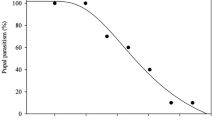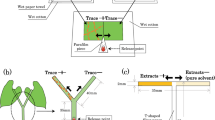Abstract
AS has been shown by Lees1, the females of Tetranychus urticae enter into diapause under the influence of a short-day treatment during their development. High temperatures tend to prevent diapause even if the photoperiod is short.
This is a preview of subscription content, access via your institution
Access options
Subscribe to this journal
Receive 51 print issues and online access
$199.00 per year
only $3.90 per issue
Buy this article
- Purchase on Springer Link
- Instant access to full article PDF
Prices may be subject to local taxes which are calculated during checkout
Similar content being viewed by others
References
Lees, A. D., Ann. App. Biol., 40, 449 (1953).
Author information
Authors and Affiliations
Rights and permissions
About this article
Cite this article
HELLE, W. Relation between Organophosphorus-Resistance and Non-Diapause in Spider Mites. Nature 192, 1314–1315 (1961). https://doi.org/10.1038/1921314a0
Issue Date:
DOI: https://doi.org/10.1038/1921314a0
This article is cited by
-
Genetics of resistance to organophosphorus compounds and its relation to diapause inTetranychus urticae Koch (Acari)
Tijdschrift Over Planteziekten (1962)
Comments
By submitting a comment you agree to abide by our Terms and Community Guidelines. If you find something abusive or that does not comply with our terms or guidelines please flag it as inappropriate.



